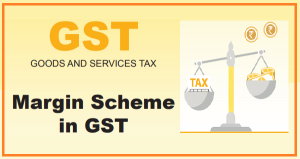GST On Second Hand Goods

AAR ruling
August 31, 2021
5 reasons to get patent registration for your business
September 9, 2021As per the GST law, GST is charged on the transaction value of the goods. However, in the case of second-hand goods, a person dealing in such goods is allowed to pay tax on the margin amount. In brief, this margin is the difference between the price at which the goods are supplied and purchased. In this article, we will explain the ‘Margin Scheme’ in GST:
Concept Of Margin Scheme In GST
Under the Margin Scheme (in GST), a taxpayer, who opts for this scheme, is allowed to pay GST on the margin amount, i.e. the difference between the value at which the goods are supplied and the price at which the goods are purchased. However, If there is no margin or negative margin, no GST is charged.
The purpose of the scheme is to avoid double taxation. In this case, the goods would have borne the incidence of tax before they re-enter the supply chain.
Valuation Of Second Hand Goods
As per Rule 32(5) of the CGST Rules, 2017, for a GST registered person who:
Deals in buying and selling of second-hand goods*,
Provides a taxable supply and
Does not avail Input Tax Credit on the purchase,
the value of supply will be the difference between the selling price and the purchase price. However, when the value of such supply is negative, it will be ignored.
*Here, second-hand goods include:
Used goods as they are (as such),
Used goods after minor processing (processing which does not change the nature of the goods).
Note: In the case of repossessed goods (goods repossessed from an unregistered defaulting borrower), the purchase value for the purpose of recovery of the loan or debt will be deemed to be:
The purchase price of such goods for the defaulting borrower
(Minus)
5% points for every quarter or part thereof. Here, the period between the date of purchase and the date of disposal (by the person making such repossession) is considered.
Notification No.10/2017-Central Tax (Rate) exempts intra-State supplies of second-hand goods received by a GST registered person – dealing in buying and selling of second-hand goods, provided that the central tax on the value of the outward supply of such second-hand goods is paid.
In case the seller incurs processing costs (repair, refurbishing, reconditioning etc.), the same should be added to the value of goods. In other words, the processing cost will be a part of the margin.
Example:
M/s ABC Ltd (Mumbai) which deals in buying and selling of second-hand cars, purchases a second-hand car (Original price INR 5,00,000) for INR 3,00,000 from an unregistered person (located in Mumbai) and sells the same after minor furbishing for INR 3,50,000 to Mr Z of Pune.
The supply of the car to the company (M/s ABC Ltd.) for INR 3,00,000 will be exempted.
The supply of the same car by the company to its customer (Mr Z) for INR 3,50,000 will be taxed, and GST shall be levied.
The value of the supply to calculate GST will be INR 50,000 (The difference between the selling and the purchase price for the company – 3,50,000 – 3,00,000).
Note: When the margin scheme is opted for a transaction of second-hand goods, the person selling the car to the company will not issue any taxable invoice and the company purchasing the car can not claim any ITC.




